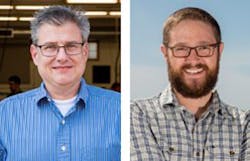New webcast: Learn how to quickly extract new information with temperature-dependent Raman and photoluminescence
| Craig Wall (left), applications lab manager at Montana Instruments, and Nicholas Borys (right), assistant professor at the Department of Physics, Montana State University, will present a webcast with Laser Focus World on optical investigations of materials at variable temperatures (cryogenic to above room temperature); the event will be held on Feb. 14, 2019. (Register here) |
A huge number of test and measurement techniques for science, industry, and medicine depend on measurements at low temperatures. For example, Raman microspectroscopy is well-suited for studying numerous properties in low-dimensional materials -- which are often best investigated at low temperatures. Many interesting phenomena emerge at cryogenic temperatures; often, additional or new information about a sample can be obtained through temperature-dependent measurements.
Optical investigations of materials at variable temperatures, especially below 80 K, can become complicated and time-consuming due to restricted sample spaces, limited optical access, and difficulties with thermal management, all of which contribute to poor efficiency and low experimental throughput. These difficulties are exacerbated when using expensive liquid-helium (flow) cryostats.
Find out how to best measure over large temperature ranges
On Feb. 14, 2019, Laser Focus World is hosting a free webcast that is all about best approaches to low-temperature experimentation, concentrating on setups where measurement can be taken at any temperature over a large temperature range (from as low as 4 K to 600 K, so from liquid-helium temperatures to substantially over room temperature).
The webcast, sponsored by Montana Instruments*, will introduce techniques to improve the efficiency and control of variable-temperature measurements in a closed-cycle (cryogen-free) system, including considerations for improved collection efficiency, thermomechanical stability, sample and optical drift, and rapid temperature control.
The presentation features two speakers: Craig Wall, applications lab manager at Montana Instruments; and Nicholas Borys, assistant professor at the Department of Physics, Montana State University.
Experimental Raman and photoluminescence (PL) data from 4 K to 600 K will be presented, along with a review of the measurement setup and parameters. Materials studied include transition metal dichalcogenides (MoS2 and WSe2) as well as single and double-layer graphene.
Please join us for this webcast, and learn how best to implement variable-temperature control for your optical experimentation. THe event will be held February 14, 2019 at 11:00 AM Eastern standard time, 10:00 AM Central standard time, 08:00 AM Pacific standard time, 16:00 Greenwich mean time.
As previously noted, the webcast is free to attend; register here.
* About the sponsor: Montana Instruments produces high-precision, variable-temperature optical measurement platforms; these closed-cycle tabletop systems can be coupled with optimized high-numerical-aperture optics, as well as magnetic control for magneto-optic test and measurement.
